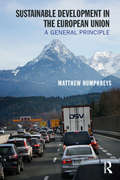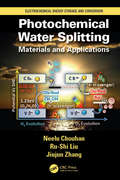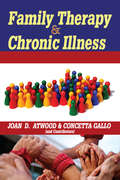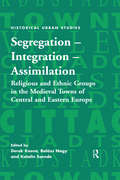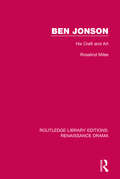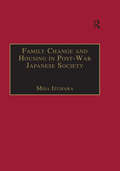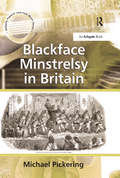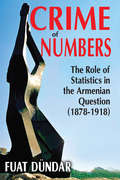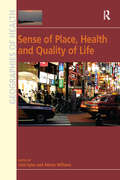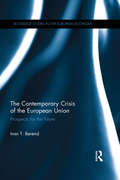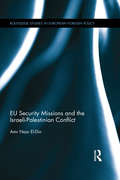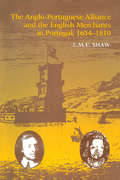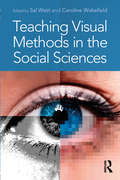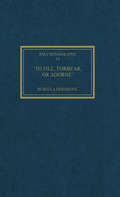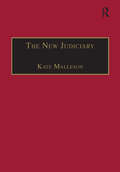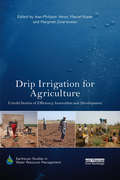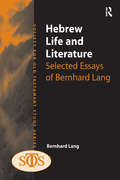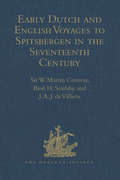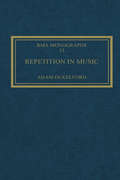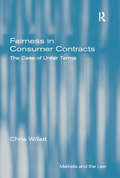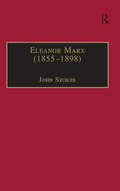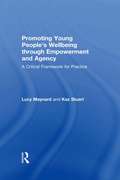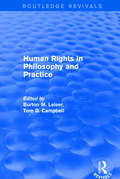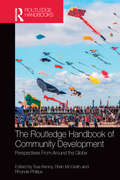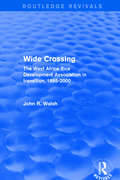- Table View
- List View
Sustainable Development in the European Union: A General Principle
by Matthew HumphreysThis book undertakes a critical appraisal of the concept of sustainable development in the European Union. In addition to existing issues of sustainability, it examines the development of a European "general principle" of sustainable development. This original, critical approach examines legal, political, and economic implications of the emergence of the principle and places the impact of such in local, national, intranational, and international contexts. While essentially focusing on the development of the principle, the discussion also includes a normative assessment of current policy and practice, and appraises European efforts in the light of international goals.
Photochemical Water Splitting: Materials and Applications (Electrochemical Energy Storage and Conversion)
by Jiujun Zhang Ru-Shi Liu Neelu ChouhanCleavage of water to its constituents (i.e., hydrogen and oxygen) for production of hydrogen energy at an industrial scale is one of the "holy grails" of materials science. That can be done by utilizing the renewable energy resource i.e. sunlight and photocatalytic material. The sunlight and water are abundant and free of cost available at this planet. But the development of a stable, efficient and cost-effective photocatalytic material to split water is still a great challenge. To develop the effective materials for photocatalytic water splitting, various type of materials with different sizes and structures from nano to giant have been explored that includes metal oxides, metal chalcogenides, carbides, nitrides, phosphides, and so on. Fundamental concepts and state of art materials for the water splitting are also discussed to understand the phenomenon/mechanism behind the photoelectrochemical water splitting. This book gives a comprehensive overview and description of the manufacturing of photocatalytic materials and devices for water splitting by controlling the chemical composition, particle size, morphology, orientation and aspect ratios of the materials. The real technological breakthroughs in the development of the photoactive materials with considerable efficiency, are well conversed to bring out the practical aspects of the technique and its commercialization.
Family Therapy and Chronic Illness
by Joan AtwoodTreatment for the chronically ill has traditionally focused on physical factors and symptoms, despite the fact that chronic illness also affects life in an emotional and spiritual way. The approach toward treatment described in this volume addresses all aspects of a patient's life, including their interpersonal experiences and relationships, presenting family therapists and family physicians as part of the same treatment team. This volume thus provides a foundation for understanding the role illness plays in family systems. The meaning an individual gives to an illness is profoundly influenced by and influences that person's social world. In turn, social culture and social networks both shape and are shaped by the individual's experiences. Exploring how the meaning of chronic illness is defined tells us much about the individual's interpersonal relations and the resultant meaning given to the person's illness. As a consequence, family therapy must be an integral part of the treatment plan for chronically ill patients . Family Therapy and Chronic Illness approaches chronic illness from a leading-edge perspective. This approach enables therapists to listen attentively to complicated narratives. Because these stories, feelings, and emotions are difficult to describe, the clients have demanding "telling" tasks while therapists have demanding "listening" tasks. This book sends an important message not just about the chronically ill, but also about their families, therapists, and doctors, and how they can work together to develop the best treatment plan possible.
Segregation – Integration – Assimilation: Religious and Ethnic Groups in the Medieval Towns of Central and Eastern Europe (Historical Urban Studies Series)
by Derek Keene Balázs Nagy Katalin SzendeThere is a widespread concern today with the role and experiences of ethnic and religious minorities, and their potential for conflict and harmony with 'host communities' and with each other, especially in towns. Interest in historical aspects of these phenomena is growing rapidly, not least in studies of the long and complex history of the towns of Central and Eastern Europe. Most such studies focus on particular places or on particular groups, but this volume offers a broader view covering the period from the tenth to the sixteenth century and regions from Germany to Dalmatia and from Epirus to Livonia, with an emphasis on the territory of medieval Hungary. The focus is on the changing nature of identity, perception and legal status of groups, on relations within and between them, and on the ways in which these elements were affected by the external political regimes and ideologies to which the towns were subjected. Many of the places examined were notable for the complexity of their ethnic and religious composition, and for their exposure to a wide range of external influences, including long-distance trade and tensions between settled and semi-nomadic ways of life. Overall the volume illustrates the variety of ways in which minorities found a place in towns - as citizens, outsiders, or in some other role - and how that could vary according to local circumstances and over time. Dealing with the formative period for modern European towns, this volume not only reveals much about medieval society and urban history, but poses questions still relevant today.
Ben Jonson: His Craft and Art (Routledge Library Editions: Renaissance Drama)
by Rosalind MilesThough he is one of the undisputed giants of English literature, Ben Jonson is known to most people only as the author of one or two masterly plays which regularly appear in the drama repertory. He is much less well-known for his whole oeuvre, which encompasses poetry, criticism, masque-making, and a lifetime of linguistic and lexicographical study. In this book, first published in 1990, the author presents a comprehensive critical study of the whole of Jonson’s output from his earliest beginnings through to the final achievement. Looking at every word he ever wrote, in drama, masque, poetry, philosophy and literary criticism, the author reveals an interesting and varied picture of Jonson. This title will be of interest to students of English literature and Renaissance drama.
Family Change and Housing in Post-War Japanese Society: The Experiences of Older Women
by Misa IzuharaThis book explores the experiences of older women in post-war Japanese society through analysis of their family and housing histories. Three broad themes - family relations, welfare systems and housing - were chosen to highlight issues surrounding the changing role and position of women in the family and society. A qualitative approach is used to address a gap in the literature and to illustrate the real-life experiences of women in Japan. Many aspects of the book are comparable, or related, to studies exploring other industrial and East Asian societies and the book thus contributes to international debates surrounding housing policy, the ageing society and the changing nature of the family. It also provides useful insights into and analysis of, Japan’s society and socio-economic system.
Blackface Minstrelsy in Britain
by Michael PickeringBlackface minstrelsy is associated particularly with popular culture in the United States and Britain, yet despite the continual two-way flow of performers, troupes and companies across the Atlantic, there is little in Britain to match the scholarship of blackface studies in the States. This book concentrates on the distinctively British trajectory of minstrelsy. The historical study and cultural analysis of minstrelsy is important because of the significant role it played in Britain as a form of song, music and theatrical entertainment. Minstrelsy had a marked impact on popular music, dance and other aspects of popular culture, both in Britain and the United States. Its impact in the United States fed into significant song and music genres that were assimilated in Britain, from ragtime and jazz onwards, but prior to these influences, minstrelsy in Britain developed many distinct features and was adapted to operate within various conventions, themes and traditions in British popular culture. Pickering provides a convincing counter-argument to the assumption among writers in the United States that blackface was exclusively American and its British counterpart purely imitative. Minstrelsy was not confined to its value as song, music and dance. Jokes at the expense of black people along with demeaning racial stereotypes were integral to minstrel shows. As a form of popular entertainment, British minstrelsy created a cultural low-Other that offered confirmation of white racial ascendancy and imperial dominion around the world. The book attends closely to how this influence on colonialism and imperialism operated and proved ideologically so effective. At the same time British minstrelsy cannot be reduced to its racist and imperialist connections. Enormously important as those connections are, Pickering demonstrates the complexity of the subject by insisting that the minstrel show and minstrel performers are understood also in terms of their own theatrical dynamics, t
Crime of Numbers: The Role of Statistics in the Armenian Question (1878-1918)
by Fuat DundarStatistics have played an important role in the recognition of the Armenian question on the international landscape as well as its "definitive solution" resulting in the Armenian genocide. The importance of statistics first surfaced at the Congress of Berlin in 1878, where differences in the approach toward numbers between the Armenian and the Ottoman Empire, and the role of statistics within the Ottoman state apparatus, became an issue. At that international gathering, the Armenian question was considered part of the "Eastern Question" paradigm of Western diplomacy. It would soon become a code word for the question of "civilization" itself.Those administering the multi-ethnic Ottoman Empire perceived the Armenian issue not only through ethnic and religious perspectives, but also through statistics. As Dundar shows, statistics became the vehicle through which the Ottoman state apparatus was forced to include non-Muslim populations of the Empire in the state apparatuses and local councils. This occurred long before the Armenian question surfaced. The aim of Ottoman reforms was to ensure that all communities participated in the affairs of the state and that such participation was proportionate to their numbers. Through its role in these reforms, statistics emerged as a constant matter of debate in the Armenian question.As a result of the Armenian genocide, the statistical record has become quite sensitive. Today, accounting for the numbers of Armenians murdered in 1915 usually means calculating the number of Armenians who were massacred or died of other causes such as disease, hunger, exhaustion, and the like during deportations or immediately after. This is a work of brilliant archival history and imaginatively uses social statistics.
Sense of Place, Health and Quality of Life (Geographies of Health Series)
by Allison WilliamsA significant body of theoretical and empirical studies describes 'sense of place' as an outcome of interconnected psychological, social and environmental processes in relation to physical place(s). Sense of place has been examined, particularly in human geography, in terms of both the character intrinsic to a place as a localized, bounded and material entity, and the sentiments of attachment/detachment that humans experience and express in relation to specific places. Scholars in a wide range of disciplines are increasingly exploring the relationship between place and health, and recently, the field of public health has been encouraged to recognize sense of place as a potential contributing factor to well-being. It is evident that over the last few decades, sense of place has developed into a versatile construct. This important book brings together work related to sense of place and health, broadly defined, from the perspective of a variety of fields and disciplines. It will give the reader an understanding of both the range of applications of this construct within approaches to human health as well as the breadth of research methodologies employed in its investigation.
The Contemporary Crisis of the European Union: Prospects for the future (Routledge Studies in the European Economy)
by Ivan T. BerendThe European Union widened and deepened integration when it introduced the Single Market and the common currency, increasing the number of member countries from 12 to 28. After a quarter of a century, the 2008 financial and economic crisis opened a new chapter in the history of European integration. Prosperity was replaced by economic crisis and then long stagnation, with ramifications far beyond the economic arena. For the first time, after more than half a century, some countries were almost forced to step out of the Union. History’s most frightening migration crisis shocked Europe and led to the strengthening of several anti-integration parties in various countries. This pioneering book discusses the nine crisis elements that could lead to disintegration of the EU. Beginning with the Greek Debt disaster this book delves into the cause of the recent European crisis and then onto the recent immigration influx and its consequences, as well as Britain’s exit from the Union. A concluding chapter, based on the facts of positive development during the crises years, gives a cautiously optimistic forecast for the future and asks the question: further integration or disintegration? This volume is of great importance to academics, students and policy makers who have an interest in European politics, political economy and migration.
EU Security Missions and the Israeli-Palestinian Conflict
by Amr Nasr El-DinThis book explores and analyses the various factors that affected the formulation of the common EU policy towards the Middle East Peace Process (MEPP), as well as the specifics of the process by which the EU created EUPOL COPPS and EUBAM Rafah. It answers two central questions: firstly, why and how did the EU decide to create and deploy these missions? Secondly, where do these two missions fit into the general EU approach to the conflict in the Middle East? Based on confidential interviews with various actors in the process, uniquely granted to the author, it reveals the mechanics of decision-making behind the scenes and argues that the EU decision to expand its role in the MEPP, through the creation of the two missions, was closely related to the EU’s defined common interests in the Middle East. Further it shows, the missions were, mainly, the result of the EU’s already established approaches to further its role in the international political arena. This text will be of key interest to scholars and students of European foreign policy, EU Politics, Middle East politics and studies, foreign policy analysis, and more broadly to international relations.
The Anglo-Portuguese Alliance and the English Merchants in Portugal 1654–1810
by L.M.E. ShawThe alliance made between Cromwell and John IV in 1654, cemented by the Articles of Marriage between Charles II and Catherine of Braganza in 1661 lasted for 156 years. Together, they provided a guarantee of Portugal’s independence and formed a framework for an expansion of trade between England, Portugal and its overseas possessions. The Inquisition had ruined the ’New Christians’ (Sephardic Jews) who had been Portugal’s principal middlemen, enabling the English merchants to play a dominant role in that expansion once they had overcome their French and Dutch rivals. They held that position until Pombal succeeded by 1770 in breaking the hold which foreigners had established over Portuguese commerce. This book is the result of many years of research into Portuguese and British archival sources. It interweaves politics, economics, religion and commerce to portray what life was like for English merchants in Portugal in the period.
Teaching Visual Methods in the Social Sciences
by Caroline Wakefield Sal WattTeaching Visual Methods in the Social Sciences presents a practical and theoretical framework for those wanting to introduce visual methods into their curricula. Drawing on the expertise of contributors from across the social sciences, the book provides a comprehensive introduction to visual methodology, learning and teaching theory, and the ethical considerations involved. Divided into three parts, the book begins with an overview of how visual methods have been used in academic research, and how this can be applied to teaching and pedagogy. It then goes on to introduce different methods, including photography, film and drawing, describing how they can be used in various locations. Finally, the book pulls everything together, advocating the wider use of teaching visual methods in further and higher education curricula across the social science subjects. The book features a plethora of examples, as well as practical resources for FE and HE teachers, making it an essential companion for anyone interested in utilising visual methods in their teaching.
'To fill, forbear, or adorne': The Organ Accompaniment of Restoration Sacred Music
by Rebecca HerissoneThis is the first study to provide a systematic and thorough investigation of continuo realization styles appropriate to Restoration sacred music, an area of performance practice that has never previously been properly assessed. Rebecca Herissone undertakes detailed analysis of a group of organ books closely associated with the major Restoration composers Purcell, Blow and Humfrey, and the London institutions where they spent their professional lives. By investigating the relationship between the organ books' two-stave arrangements and full scores of the same pieces, Herissone demonstrates that the books are subtle sources of information to the accompanist, not just short or skeleton scores. Using this evidence, she formulates a model for continuo realization of this repertory based on the doubling of vocal parts, an approach that differs significantly from that adopted by most modern editors, and which throws into question much of the accepted continuo practice in modern performance of this repertory.
The New Judiciary: The Effects of Expansion and Activism
by Kate MallesonDuring the last thirty years, the judiciary has undergone an unprecedented expansion in its size and power. Judges now have more influence over our private and public lives than ever before. The effect of this change has been to transform the judiciary from an inward-looking elite into an increasingly heterogeneous professional body. 'The New Judiciary' examines the developments which have taken place in the appointment, training and scrutiny of judges as a result of the expanding judicial role. It highlights the increasing tension between the requirements of judicial independence and accountability which these changes are producing. The traditional insulation of the judiciary from all external influences is being challenged by the need for greater openness and public scrutiny of the judicial process. The passing of the Human Rights Act 1998, incorporating the European Convention on Human Rights into domestic law represents another stage in this process by expanding the policy-making role of the senior judiciary still further. As a result, the continuing modernisation of the judiciary, which is the subject of this book, will be a increasingly important feature of the legal and political process in the years ahead.
Drip Irrigation for Agriculture: Untold Stories of Efficiency, Innovation and Development (Earthscan Studies in Water Resource Management)
by Jean-Philippe Venot Marcel Kuper Margreet ZwarteveenInitially associated with hi-tech irrigated agriculture, drip irrigation is now being used by a much wider range of farmers in emerging and developing countries. This book documents the enthusiasm, spread and use of drip irrigation systems by smallholders but also some disappointments and disillusion faced in the global South. It explores and explains under which conditions it works, for whom and with what effects. The book deals with drip irrigation 'behind the scenes', showcasing what largely remain 'untold stories'. Most research on drip irrigation use plot-level studies to demonstrate the technology’s ability to save water or improve efficiencies and use a narrow and rather prescriptive engineering or economic language. They tend to be grounded in a firm belief in the technology and focus on the identification of ways to improve or better realize its potential. The technology also figures prominently in poverty alleviation or agricultural modernization narratives, figuring as a tool to help smallholders become more innovative, entrepreneurial and business minded. Instead of focusing on its potential, this book looks at drip irrigation-in-use, making sense of what it does from the perspectives of the farmers who use it, and of the development workers and agencies, policymakers, private companies, local craftsmen, engineers, extension agents or researchers who engage with it for a diversity of reasons and to realize a multiplicity of objectives. While anchored in a sound engineering understanding of the design and operating principles of the technology, the book extends the analysis beyond engineering and hydraulics to understand drip irrigation as a sociotechnical phenomenon that not only changes the way water is supplied to crops but also transforms agricultural farming systems and even how society is organized. The book provides field evidence from a diversity of interdisciplinary case studies in sub-Saharan Africa, the Mediterranean, Latin America, and South Asia, thus revealing some of the untold stories of drip irrigation.
Hebrew Life and Literature: Selected Essays of Bernhard Lang (Society for Old Testament Study)
by Bernhard LangBernhard Lang, known for his contributions over several decades to biblical anthropology, offers in this volume a selection of essays on the life and literature of the ancient Hebrews. The subjects range from the Hebrew God, the world-view of the Bible, and the formation of the scriptural canon, to peasant poverty, women's work, the good life, and prophetic street theatre. The stories of Joseph, Samson, and the expulsion from Paradise are analysed, and in a departure from the Old Testament, the priestly origins of the Eucharist are considered. Insight into the Hebrew mentality is facilitated by the arrangement of the essays, reflecting the three strata of the ancient society: the peasants, with their common concerns of fertility and happiness; warriors, their martial pursuits, and the divine Lord of War; and the wise - prophets, priests, and sages.
Early Dutch and English Voyages to Spitsbergen in the Seventeenth Century: Including Hessel Gerritsz. 'Histoire du pays nommé Spitsberghe,' 1613 and Jacob Segersz. van der Brugge 'Journael of dagh register,' Amsterdam, 1634 (Hakluyt Society, Second Series)
by Basil H. Soulsby J.A.J. de Villiers'Early Dutch and English Voyages' translated into English, for the first time, by Basil H. Soulsby, F.S.A., of the British Museum; Segersz's text translated into English, for the first time, by J. A. J. de Villiers, of the British Museum. Edited, with Introduction and Notes, by Sir W. Martin Conway, F.S.A. With affidavits by English merchants and seamen relating to happenings at Spitzbergen in 1618, and two documents telling of events there in 1634-5, taken from Public Record Office, State Papers Domestic. Including a bibliography of Spitzbergen, pp. ix-xiv. This is a new print-on-demand hardback edition of the volume first published in 1904.
Repetition in Music: Theoretical and Metatheoretical Perspectives
by Adam OckelfordThis monograph examines the place of repetition in perceived musical structure and in theories of music. Following a preface and introduction, there are four main chapters: 'Theory', 'Analysis', 'Metatheory and Meta-analysis', and 'Cognition and Metacognition'. Chapter 2 (Theory) sets out the principles underlying the creation and cognition of musical structure developed by the author in earlier studies, in the dual context of David Lewin's mathematically based theory of musical intervals and transformations and Gilles Fauconnier's concept of mental spaces (which was formulated in the context of cognitive science). Chapter 3 (Analysis) shows the theory in operation in relation to the first movement of Mozart's piano sonata K.333. It indicates how structural issues may be related to considerations of aesthetic response and musical 'worth' through comparison with J.C. Bach's Sonata op. 5 no. 3. Chapter 4 (Metatheory and Meta-analysis) uses the new theory to interrogate the propositions underpinning set theory and transformations, offering a psychomusicological critique and potential development of, for example, the work of Forte, Morris, Isaacson and Straus. This enables issues raised earlier in relation to the work of Lewin to be addressed. In conclusion, in Chapter 5 (Cognition and Metacognition), the matter of cognitive preferences and constraints is considered in relation to repetition in music, which permits a final investigation of different approaches to musical analysis to be undertaken. In summary, by synthesising the findings of diverse earlier work in the context of the new theory, it proves possible to move thinking forward on a number of fronts, and to indicate potential directions for future empirical and analytical developments.
Fairness in Consumer Contracts: The Case of Unfair Terms (Markets and the Law)
by Chris WillettThis book focuses on unfair contract terms in consumer contracts, in particular the existing legislation and the proposals by the Law Commissions for a new unified regime. In this context it considers, in particular, what we mean by fairness (both procedurally and in substance); the tools used; the European dimension; the move from general principles from the more piecemeal approach typical in UK legal tradition; and the further move in this direction as a result of the Unfair Commercial Practices Directive.
Eleanor Marx: Life, Work, Contacts (The Nineteenth Century Series)
by John StokesKarl Marx's youngest daughter Eleanor (1855-98) is one of the most significant figures in the cultural politics of the late nineteenth century. As a feminist and radical socialist she never flinched from confrontation; as an aspiring actress, working journalist and literary translator she advanced contemporary understanding of Flaubert, Ibsen and Shakespeare. This collection of newly commissioned essays helps to establish the full extent of her outstanding achievements.
Promoting Young People's Wellbeing through Empowerment and Agency: A Critical Framework for Practice
by Lucy Maynard Karen StuartThe terms ‘wellbeing’, ‘empowerment’ and ‘agency’ are common parlance in policy and practice with children, young people and families (CYPF), yet are often misused or not fully understood. Further, there is a disconnect between these abstract concepts and tangible practice with CYPF. This book bridges the theory-practice divide, offering a clear and definitive guide to concepts and practical ways to develop CYPF wellbeing. It examines the concept of wellbeing and its intrinsic relationship to social justice both theoretically and through case study material, and locates these practices within critical pedagogy. The book highlights a range of practice with CYPF of various ages, in formal and non-formal learning situations, engaged in a range of different programmes including learning, reduction from offending, social action and tackling targeted needs. Each chapter highlights relevant policy, research and practice examples to ensure that the book is relevant to a variety of readers. This book will benefit students and practitioners who work with young people to realise wellbeing and to embed critical pedagogy in their practice. It also provides a frame of reference to critically engage in policy analysis and is essential reading for social workers, teachers, police support officers and anyone working to support CYPF to become empowered.
Revival: Human Rights in Philosophy and Practice (2001)
by Burton M. Leiser Tom D. CampbellThis title was first published in 2001. The essays in this highly cosmopolitan collection were selected from over 250 contributions presented at the 19th World Congress in Philosophy of Law and Social Philosophy (IVR) held in New York in 1999. They represent a cross-section of contemporary work on human rights derived from eleven different countries.
The Routledge Handbook of Community Development: Perspectives from Around the Globe
by Rhonda Phillips Sue Kenny Brian McGrathThe Routledge Handbook of Community Development explores community development theory and practice across the world. The book provides perspectives about community development as an interactive, relevant and sometimes contradictory way to address issues impacting the human condition. It promotes better understanding of the complexities and challenges in identifying, designing, implementing and evaluating community development constructs, applications and interventions. This edited volume discusses how community development is conceptualized as an approach, method or profession. Themes provide the scope of the book, with projects, issues or perspectives presented in each of these areas. This handbook provides invaluable contextualized insights on the theory and practice of community development around core themes relevant in society. Each chapter explores and presents an issue, perspectives, project or case in the thematic areas, with regional and country context included. It is a must-read for students and researchers working in community development, planning and human geography and an essential reference for any professional engaged in community development.
Wide Crossing: The West Africa Rice Development Association in Transition, 1985-2000
by John R. WalshThis title was first published in 2001. The West Africa Rice Development Association (WARDA) was established in the early 1970s to help farmers increase rice production. Africa is the only continent whose population has grown faster than its food production; this shortfall provokes the syndrome of poverty, hunger and violence there. WARDA first attempted to alleviate the food deficit by introducing high-yielding imported crop varieties. This strategy drove green revolution in Asia and Latin America but failed in Africa. This book recounts WARDA's revival after nearly succumbing in the 1980s. Not only did the programme have to deal with a harsh agricultural environment, but also with severe economic, political and social constraints. WARDA made crucial advances in rice research and also coped successfully with non-scientific challenges. WARDA serves as a thriving example of a combined international research center and a regional organization.
